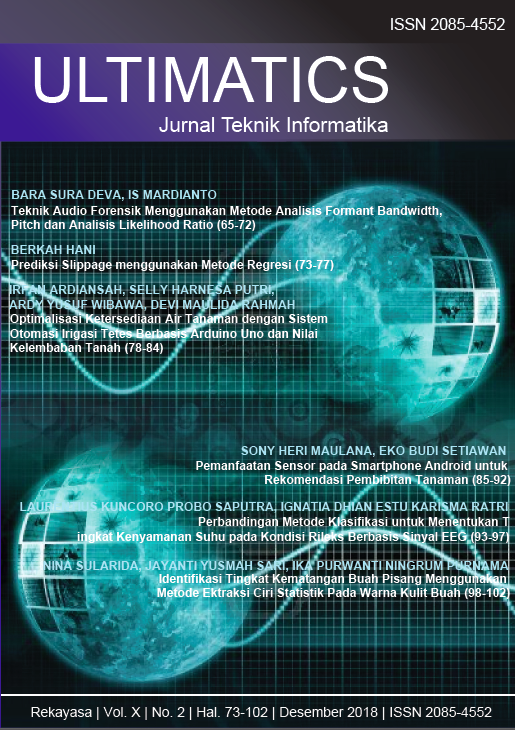Teknik Audio Forensik Menggunakan Metode Analisis Formant Bandwidth, Pitch dan Analisis Likelihood Ratio
DOI:
https://doi.org/10.31937/ti.v10i2.936Abstract
Audio forensik merupakan cabang ilmu digital forensik dengan metode ilmiah berupa proses penganalisaan data yang digunakan untuk menyelidiki dan membangun fakta – fakta di persidangan. Subyek suara dapat menunjukkan identitas seseorang melalui metode voice identification dengan teknik komparasi data. Jika hasilnya identik dengan suara pelaku maka barang bukti rekaman suara dapat digunakan sebagai alat bantu penegakkan hukum di pengadilan. Perbandingan data suara, dilakukan melalui analisis statistik pitch, formant, bandwitdh, spektogram dan likelihood ratio untuk mendapatkan data kuantitatif dan data visual dari subyek suara yang di investigasi. Audio forensik menggunakan dua metode utama untuk menganalisa keaslian barang bukti rekaman suara yaitu metode analisis formant bandwidth dan metode analisis likelihood ratio.
Analisis formant bandwidth menggunakan metode Anova. Selain menggunakan metode Anova, analisis dengan metode likelihood ratio dilakukan untuk menentukan nilai skor rekaman suara. Penggunaan analisis ini merupakan metode yang dapat membantu dalam menentukan identik atau tidaknya suatu rekaman barang bukti . Sehingga dapat menjadi tolak ukur keakuratan analisis formant bandwidth yang memiliki tingkat kebenaran 95%.
Downloads
Downloads
Published
How to Cite
Issue
Section
License
Authors retain copyright and grant the journal right of first publication with the work simultaneously licensed under a Creative Commons Attribution-ShareAlike International License (CC-BY-SA 4.0) that allows others to share the work with an acknowledgement of the work's authorship and initial publication in this journal.
Authors are able to enter into separate, additional contractual arrangements for the non-exclusive distribution of the journal's published version of the work (e.g., post it to an institutional repository or publish it in a book), with an acknowledgement of its initial publication in this journal.
Copyright without Restrictions
The journal allows the author(s) to hold the copyright without restrictions and will retain publishing rights without restrictions.
The submitted papers are assumed to contain no proprietary material unprotected by patent or patent application; responsibility for technical content and for protection of proprietary material rests solely with the author(s) and their organizations and is not the responsibility of the ULTIMATICS or its Editorial Staff. The main (first/corresponding) author is responsible for ensuring that the article has been seen and approved by all the other authors. It is the responsibility of the author to obtain all necessary copyright release permissions for the use of any copyrighted materials in the manuscript prior to the submission.















